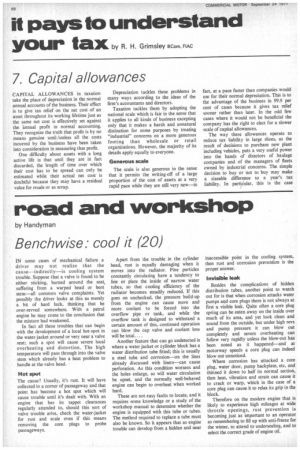it pays to understand
Page 52

Page 53

If you've noticed an error in this article please click here to report it so we can fix it.
your tax by R. H. Grimsley Bcom.Rac
7. Capital allowances
CAPITAL ALLOWANCES in taxation take the place of depreciation in the normal annual accounts of the business. Their effect is to give tax relief on the net cost of an asset throughout its working lifetime just as the same net cost is effectively set against the 'annual profit in normal accounting. They recognize the truth that profit is by no means genuine until/unless all the costs incurred by the business have been taken into consideration in measuring that profit.
One difficulty about assets with a long active life is that until they are in fact discarded, the length of time over which their cost has to be spread can only be estimated while their actual net cost is doubtful because they may have a residual value for resale or as scrap. Depreciation tackles these problems in many ways according to the ideas of the firm's accountants and directors.
Taxation tackles them by adopting the national scale which is fair in the sense that it applies to all kinds of business excepting only that it makes a harsh and unnatural distinction for some purposes by treating "industrial" concerns on a more generous footing than wholesale or retail organizations. However, the majority of its details apply equally to everyone.
Generous scale The scale is also generous in the sense that it permits the writing-off of a large proportion or the cost of assets at a very rapid pace while they are still very new—in
fact, at a pace faster than companies would use for their normal depreciation. This is to the advantage of the business in 99.9 per cent of cases because it gives tax relief sooner rather than later. In the odd few cases where it would not be beneficial the company has the right to elect for a slower scale of capital allowances.
The way these allowances operate to reduce tax liability in large slices, as the result of decisions to purchase new plant including vehicles, puts a very useful power into the hands of directors of haulage companies and of the managers of fleets owned by industrial concerns. The simple decision to buy or not to buy may make a sizeable difference to a year's tax liability. In particular, this is the case where a financial year is known to be going exceptionally well by about the ninth or 10th month and a purchase of new assets already planned is executed before the ending of the financial year.
The large allowances given in the first year, generally 80 per cent of the cost of a machine but with some variations from this norm, is given in full no matter how late in the financial year the machine is purchased. Private cars are in a different scale and managers responsible for both trucks and cars should keep the distinction in mind.
Corporation Tax
For example, if two lorries jointly costing £10,000 are bought in December by a company whose financial year ends on December 31, they will take £8000 off the taxable profit for that same year, while relief for that remaining £2000 would be spread over subsequent years. If the trucks were not bought until the next January it would be a whole extra year before their cost would affect the tax liability.
The cash value of the allowances depends Dn the rate of corporation tax. Supposing this remains at 40 per cent, the cash value I allowances of £8000 is 40 per cent of this sum which equals £3,200, because £8000 will have been taken off the taxable profit thus reducing the tax demand for that year. One slight snag to this planning is that Ilaving a good profit is not always the same thing as having plenty of spare cash. Very )ften the firm's funds have been tied up in he shape of extra debtors and other assets a) that it is not easy to find ready liquid "acilities to pay either the tax or for new nachines.
Sensible spending
This means some careful planning is dways needed but with the vital difference hat by spending sensibly on new vehicles or )ther machines the company's future :arning power is strengthened whereas by neekly spending the profit on paying tax, mly the Exchequer is strengthened.
Special attention is drawn to the :xpression "sensible spending". The froposition is being put forward that when i company is making good profits an ideal vay of using them is to strengthen the iusiness by keeping its fixed assets (plant; 'chicks, etc) in first-class order, having plenty of them and renewing them requently. The whole idea is to put the firm a a position to meet competition and to run uccessfully through tougher years by Laving started those years from a position ■ f strength.
Whether the actual selection of the new ,ssets is correct for the business and vhether they are of the kinds which can be ised profitably as distinct from merely itting around idly, is very much a matter or the management. The tax angle ncourages the policy but it is the skill of he managers and directors which settles ðer the plan will be carried out ffectively.










































































































